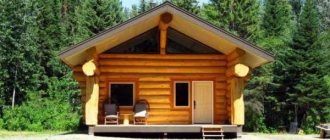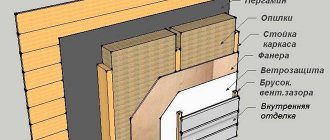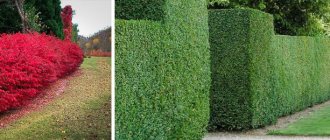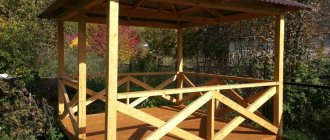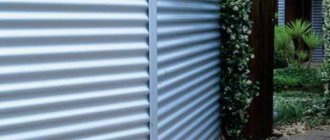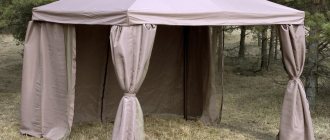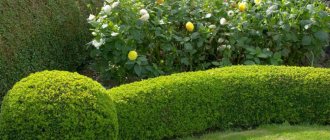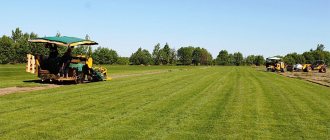Nowadays, owners of their own houses and summer cottages use different varieties of deciduous, coniferous and flowering plants. Recently, the topic of coniferous plantings for hedges was actively discussed on the forum. This is what our regular user Asya1974 writes:
Asya1974
I'm asking for advice. I want to plant 5-7 pieces of Korean fir along the front part of the fence. What I want: a beautiful, always elegant appearance, exactly a coniferous planting. Maybe consider other plants for such purposes? (but you need evergreens).
We have prepared the top 10 evergreen and deciduous plants that are suitable for creating beautiful decorative fences.
Tips for building a living gazebo
Building the Foundation: Trees, Posts or Frame?
Do you need a full structure of living trees or just want to add a few climbing plants to your gazebo? You have an alternative choice of three options:
With frame
- Trees . For construction, you will need a maximum of tying wire and garter cord. The entire structure will grow itself from fast-growing trees, which will protect you from the sun with their crowns.
- Pillars . By installing permanent pillars and adding wooden sheathing, you can create a full-fledged gazebo from plants. At the peak of the season, the shoots will gain chlorophyll, and the buds will bloom, delighting the owners and guests of summer residents with a pleasant aroma.
- Frame . A classic gazebo decorated with several climbing plants. This approach is appropriate when you want to relax not only in the July heat, but also in September and October autumn.
Interior lighting
Since leaves and branches almost completely isolate the room from sunlight, it makes sense to install a hanging lantern inside. It will bring two interesting highlights:
- Practical - the room will be illuminated in the evening when you want to sit inside.
- Aesthetic - if you light a lantern and look at the gazebo from the outside, you will create an interesting light effect of a sphere. The building will be illuminated from the inside, which is very beautiful.
Selection of climbing plants and trees
Of the trees, the most preferred option is Chinese poplar . It grows quickly, rarely gets sick and adapts perfectly to the required shape. Other, less practical trees are also possible:
From Chinese poplar
- Mountain ash.
- Linden.
- Spruce (the building turns out to be very dark).
- Apple tree.
- Pear.
Regarding green shoots and flowers: we recommend that you study the publication on climbing plants, which lists more than a dozen options for your gazebo. Honeysuckle, wisteria, clematis - there are quite a lot of ideas.
Ideas for living gazebos
Below we have prepared for you a selection of 14 photographs, each of which can decorate and complement your summer cottage.
After all, Alexander Ukolov : “The dacha is often overloaded with buildings - a barbecue, a barn, a bathhouse, a toilet. But the living recreation area does not take up much space and fits perfectly into the overall landscape design of the site.”
Selecting roofing material
After you have decided on the shape of the future structural element, the question arises: “What should the roof be made of?” The selection of the finishing roof covering must be taken very seriously, because it will determine the performance qualities of the roof, its wear resistance and durability, and the appearance of the entire garden area.
Therefore, you should not save much on roofing materials; pay attention not to the price, but to their weight, technical characteristics and methods of fastening to the base.
Attention! To avoid possible problems associated with excessive load of the roof on the foundation of the structure, it is better to opt for a coating that is not too heavy.
Covering materials can be hard or soft. The first type includes the following varieties: slate, tiles, composite slabs, shingles, etc. Soft options - roofing felt, bitumen shingles, polycarbonate, ondulin.
- Lawn laying
A garage at the dacha is not a warehouse, but a modern and comfortable space!
Diesel generator for home: which one to choose?
Before sending it to a hardware store, be sure to make a design for the roof you are installing yourself; this will allow you to accurately calculate the required volume of roofing material and calculate the load that the rafter system will have to withstand.
When making calculations, be sure to take into account the following design nuances:
- total mass of rafters;
- the severity of the roofing pie;
- climatic features of the area (snow and wind load);
- the mass of equipment planned for fastening to the roof: ventilation devices, antennas, etc.
It is this data that will allow you not to make a mistake in your choice and create a strong and stable structure on your site.
Barberry Tumberga
Hedges made from Barberry Tumberg shrubs are valuable for their dense crown and a huge variety of shades of yellow and red in the autumn. The plant is resistant to the main diseases of the barberry family: powdery mildew and rust. Low bushes (up to 1 m) bloom for about 3 weeks from the end of May (beginning of June). The shrub throws out a few inconspicuous inflorescences. They are almost invisible among the foliage.
Thumberga barberry hedge
The most popular varieties of Barberry Tumberg for forming hedges:
- Aurea. Diamond-shaped leaves change color from bright yellow in spring to almost orange in autumn.
- Erecta - a columnar bush attracts with its crown shape and bright green foliage.
- Green Cutpet. The cushion-shaped spreading form of the shrub changes from green to reddish in autumn.
- Golden Ring. The variety is distinguished by purple leaves with yellow edging.
- Red Rocket. A shrub with erect branches growing from the root, covered with red-brown foliage.
Most representatives of Barberry Tumberg grow slowly. The culture is unpretentious in care. In addition to weekly watering of shrubs (at the root), in the fall it is necessary to add humus or compost to the root zone of the soil (1 bucket for an adult bush).
Tumberg barberry foliage
Start from the site
Living flowering arbors can only be created on warm and sunny areas that are sufficiently protected from cross winds and drafts. Bright lighting is necessary not only to create a tree frame, but also for climbing vines that will be planted around it and will not be able to bloom in the shade.
The first thing to think about is the recreation area itself:
- The territory is marked out by identifying an area of the desired shape (not necessarily the simplest - round) with a diameter of at least 3 m.
- Prepare the soil for a circle of plants, allocating 1-2 m around the perimeter of the circle, digging the soil deeply, adding organic and mineral fertilizers.
- Carefully level the soil inside the circle, if possible immediately creating a covering or leaving the final layer of decorative mulch or gravel for the last stage.
- In the middle of the prepared planting strip, using strong and wide wooden pegs placed every 0.7-2 m, mark the frame of the future gazebo and a landmark for planting trees. Such supports will help young plants, serve as “posts” for tying up short branches and will allow the branches to be more firmly fixed and guided, and after the plants grow, they can be removed. Sometimes the pegs are connected together with slats or wire to create a strong base, but this is not necessary.
Only after the recreation area is ready (or almost ready) do they begin planting the plants themselves.
Gazebo entwined with grapes and roses
Middle hedge
Such a fence at the dacha will fit perfectly into the landscape of any site. Having a height of one and a half meters, it will help to fence off the area. The best shrubs for this hedge will be:
- fruit-bearing;
- conifers;
- blooming.
Sometimes it also has a protective function by adding rosehip or barberry.
How to build a hut at the dacha with your own hands
To build a hut, you must first determine your priorities. First, decide what needs it will be used for. Most often, the building is used as a children's building, for games and fun for kids. We have already discussed the hut on the playground, like the tree house, earlier, and therefore there is already a source for detailed information.
If the hut is being built for other needs, say, will serve as a gazebo, then we are ready to talk about this now.
The base of the hut is soil and a special ditch for installing frame materials. There is no need for any pouring or foundation here; just use a shovel and dig a trench around the perimeter of the future structure. Next, it is enough to install two supporting elements for the structure using a beam or log. The cross between the supporting elements will become the base of the roof and the upper base of the walls. Now, on the simplest frame, you can lay the branches that will make up the hut, securing their upper part to the base, and the lower part to the ditch that we have prepared.


